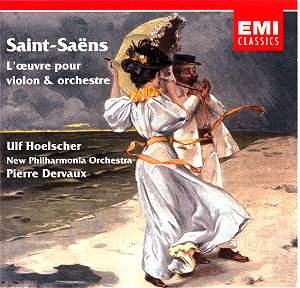This
toothsome collection remains just as desirable as when it was
first issued on three or was it four LPs, back in 1977. EMI are
quite right in keeping it in the catalogue. It will continue to
command steady sales.
Saint-Saëns
is a master of tune-spinning and of the orchestral palette. This
is fragrant writing in the line of the Mendelssohn Violin Concerto
and Octet and the violin concertos by Bruch (No. 1), Glazunov
and Karłowicz . These works are sugared rather than salted,
charm-woven rather than vehicles for great angst or profundity;
no harm in that.
The
familiar works are the Third Concerto, Havanaise and the
Introduction and Rondo Capriccioso. Of course when I say
'familiar' I mean familiar on disc. When did you last hear any
of these in concert? The Third is well enough known not to need
much commentary. After a scorching performance it is a mark of
EMI's attention to aesthetic detail that a very long gap is left
before we breathe the sultry Cuban air in Havanaise (also
superbly recorded by both Grumiaux and Kogan). Hispanic atmosphere
and sensitive attention to dynamic contrasting by Dervaux and
Hoelscher as well as an all-conquering pride and impulsive dash
make you realise that the Caprice Andalou deserves
to be just as well known as the Introduction and Rondo Capriccioso
and the Havanaise. Quickfire playing and romantic themes
are boldly despatched. The Prélude from La Déluge
with its grave steady fugal character is a work of devotional
atmosphere as befits the overture to the composer's 1875 oratorio.
Listen
to the eager acceleration of Hoelscher in the finale of the Griegian
First Concerto which, but for its name and three movements,
could easily have passed for one of the nine short genre pieces
which fill out the two discs around the core of the three concertos.
This is a short work (almost 12 minutes) of shivering Beethovenian
fire - full of incident and invention. Bruch's First Concerto
is a model (conscious or unconscious) for these concertos. Bruch
also wrote three but it was his first that held the high ground
while his other two languished. In the case of Saint-Säens
the Third has found a place in record catalogues while the other
two have had to struggle against the odds. The Second Concerto
has an Ossian-inflected andante espressivo with harp
figures lending depth to a sentimentality teetering close to Bruch's
Scottish Fantasy. This makes way for a dashing Polacca
scherzando with sideways glances towards Beethoven's 'dance
apotheosis' - Seventh Symphony.
La
Muse et le poète is a sober double concerto in
which Ralph Kirshbaum's cello cuts a deeper path than the violin.
This is soulful, not in the manner of Bruch's Kol Nidrei,
but rather like the Beethoven Violin Concerto yet with a Tchaikovskian
honeyed nostalgia over the proceedings. The explosive little Valse-Caprice
is as arranged by Ysaÿe. The two Romances
are just that: well rounded, not impulsive, musing and touching
though lacking a strong profile.
The
notes by Michel Roubinet cover the ground at express speed. The
essentials are there but little else.
There
is no compettion although the shorter works have been gathered
onto a much more recent French EMI collections with Plasson and
Dumay which I have not heard. Both Hyperion and Claves have offered
single CDs of the three concertos but Hoelscher has deep reserves
of virtuosity and reflective fibre and a generous way with their
expression. You are unlikely to want to wander far from this set
which still sounds very good if inevitably slender-toned by comparison
with today's very best.
There
is no reason to go looking further afield. Intrigued? Then buy
this set with confidence.
Rob
Barnett
